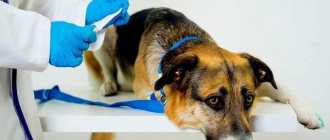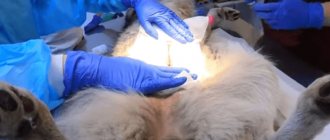Surgical intervention that involves removing reproductive function in dogs is called castration. This type of operation is recommended to prevent the occurrence of unwanted matings and to significantly improve the working properties of adult dogs. Castration of dogs is a fairly serious operation, the consequences of which can have a number of side effects. Before deciding in favor of castration, it is necessary to carefully evaluate all the pros and cons of the operation.
Castration or sterilization
First, let's figure out what dog castration is and how it differs from sterilization.
Typically, people who have never had a cat or dog believe that castration is a “male” operation, and sterilization is a “female” operation. However, these procedures differ not depending on the sex of the animal, but according to the principle of implementation. Castration of dogs means:
- in males – surgical removal of the testes (testicles),
- in females – surgical removal of the ovaries, or the ovaries along with the uterus.
Sterilization of dogs involves:
- in males - ligation of the seminal ducts,
- in bitches – tubal ligation.
As a result of both castration and sterilization, the dog permanently loses the ability to reproduce. After castration, the dog completely loses interest in the opposite sex, and female dogs go into heat. And after sterilization, the animal can mate, since the genitals are preserved and continue to produce hormones.
Medical indications: 3 situations when castration is necessary
There is nothing unnecessary in the body - the main argument of opponents of castration. This is true. The problem is that in nature, canines live on average 6-8 years. And our pets last much longer, 10-16 years. And with age, some earlier and some later, diseases associated with the activity of the testes arise. The only treatment and the only prevention is castration.
Oncology
Neoplasms of the testes are a common occurrence in older dogs over 7-8 years of age. There are several types of testicular tumors:
- Sertolioma.
This is a tumor consisting of special Sertoli cells. It produces female sex hormones - estrogens. It is with this “feminization” that the symptoms are associated:
- Symmetrical baldness on the sides, neck, armpits. At the same time, the dog does not itch, there is no inflammation or scratching.
- The skin becomes thin and dark.
- The dog can become an object of sexual interest among other males, but he himself does not show activity when meeting a female in heat.
- The penis becomes smaller and the skin of the prepuce sag.
Sertolioma is insidious in that it does not always cause testicular enlargement. It can be difficult for a doctor to convince the owner of the need for surgery and subsequent histological examination of the removed testis. The evidence base in this case is ultrasound of the testes and determination of hormone levels in the blood.
- Seminoma.
This tumor consists of the epithelium of the seminiferous tubules. The average age of onset of seminoma is 10 years. The tumor can behave as benign; it rarely metastasizes. However, it increases in size rapidly and requires urgent surgical intervention.
Seminoma on the left, unaffected testicle on the right
Malignant tumor of the testis
- Leydigoma.
With a Leydig cell tumor, the amount of testosterone in the body begins to go off scale. This leads to an enlarged prostate and tumors around the anus. Perianal tumors can be either benign (adenomas) or malignant (adenocarcinomas).
Prostatitis
Prostatitis occurs in uncastrated male dogs older than 5-7 years. Benign enlargement of the prostate gland in a male dog goes unnoticed for a long time. Only an advanced form of prostatitis causes difficulty urinating and defecating. Prostate infections produce small amounts of pus or blood in the urine. Regular mating prevents congestive prostatitis, but it is impossible to ensure it throughout life.
Treatment of prostate adenoma or bacterial prostatitis begins with surgical or chemical castration. A decrease in testosterone levels causes almost complete atrophy of the gland within 3 months after surgery.
Much more dangerous is prostate adenocarcinoma, a malignant tumor of the gland. In this case, treatment is almost impossible. Not every surgeon will undertake to remove the entire prostate followed by reconstruction of the urethra (urinary canal). But even such a complex operation will not protect against the occurrence of metastases.
When I see a patient like this, I can't stop thinking that castration at a young age would have protected him from prostate tumors.
Perineal hernia
When the prostate enlarges more and more, and the owners do nothing, the result is the same - a perineal hernia. A huge gland mechanically presses on the intestines. To defecate, the dog strains hard. As a result, the weak muscles of the perineum creep apart and the organs of the pelvic cavity fall out under the skin. In the hernial sac, which looks like a huge tumor to the right or left of the anus, there may be: prostate, bladder, intestinal loops. If any organ is injured, the dog may die.
Perineal hernia in a Yorkie
Perineal hernia repair is a long and labor-intensive operation. But despite this, the surgeon must also perform castration, otherwise the root cause of the disease will not be eliminated.
Why neuter your dog?
As we found out, castration of a dog means removal of the reproductive organs of an animal of any gender. But why is this operation necessary? And why can’t we limit ourselves to sterilization?
Veterinarians recommend castrating females and males in some cases.
- Cryptochrism is a condition where one or two testicles in a male dog are not descended into the scrotum. Due to the congenital anomaly, there is a high probability of developing an egg tumor, so it is better to take preventive measures.
- Prostatitis, cysts and other neoplasms in the gonads are direct indications for castration of male dogs.
- Complications in a bitch during pregnancy or after giving birth can threaten the life and health of the animal. If the dog has reached sexual maturity, there is a risk of uncontrolled conception, which is important to prevent with surgery.
- The development of oncology of the reproductive system and pyometra (purulent endometritis) in bitches is radically prevented.
- If the dog is used as a sled dog, guard dog, hunting dog or guide dog, castration will improve its performance. After castration, the animal will not run away in search of a partner and will be able to concentrate on the task.
- The dog's behavior may be inappropriate due to an excess of sex hormones. It is necessary to castrate male dogs with bouts of causeless aggression, spontaneous ejaculation, and frequent random erections. After the operation, the pet’s behavior changes for the better - the dogs stop marking territory, rushing at other dogs, do not try to dominate the owner, and become more manageable and balanced. Changes in character are expressed more clearly in males compared to females. Now they go outside for walks and toilets, not for adventure. However, in this situation, it is important to distinguish between hormonal imbalance and the usual bad manners of the pet. If the first is corrected by castration, then flaws in training and bad character will not go away.
Thus, castration of dogs solves problems that cannot be solved through sterilization. Experts recommend sterilizing all bitches from whom it is not planned to produce offspring, and if indicated, it is necessary to castrate them. With regard to males, it is worth focusing on the health, behavior and lifestyle of the dogs; castration is carried out selectively.
The need for castration is an individual question
Castration is by no means a mandatory procedure.
Only operate on your pet if you are sure it will benefit him.
Of course, the procedure is necessary if there is a serious threat to the dog’s health. But you don’t need to do this solely for your own peace of mind or in the hope of thus correcting the gaps in the education of the beast. Any surgical intervention is a risk to the health of the animal. You should not subject your friend to it unless there is a good reason for it.
Disadvantages of castration
Castration of a dog leads to changes in hormonal levels and may have side effects:
- the operation is performed under general anesthesia, which sometimes leads to allergies, disruptions in the gastrointestinal tract, heart and respiratory system;
- subsequently there is a possibility of disruption of the functioning of the urinary system. Thus, some bitches develop urinary incontinence;
- a neutered dog is not immune from sleep disturbances and spatial disorientation;
- the risk of hypothyroidism, obesity, vascular problems, and bone sarcoma increases.
Basic methods of sterilizing dogs
Before the procedure, the animal must be thoroughly examined. When choosing a particular sterilization method, the owner of a shepherd dog should take into account the advice of a veterinarian.
Endoscopic sterilization is not a separate method; it is just one way to gain access to internal organs. Traditional castration, tubal occlusion, or oophorectomy can be performed endoscopically. The operation is performed under general anesthesia, all actions are carried out using special equipment - an endoscope. Before the procedure begins, the shepherd's abdominal cavity is filled with gas, causing the organs to be separated from the muscle tissue.
Optimal age of a dog for castration
It is best to have your dog neutered shortly after puberty. Because of this, the ideal age for neutering varies depending on the breed and health of the individual dog. In miniature pets, weighing up to 10 kg, puberty occurs at 5-8 months of age, in representatives of medium and large breeds - from 8 months to 1 year, in giants this period reaches 2 years. Your veterinarian will tell you at what age to neuter your dog after examining the animal.
Important: castration of a dog for medical reasons is carried out regardless of its age.
Choosing the optimal time for castration really makes sense, if possible. An operation performed very early can lead to abnormalities in the puppy’s development and problems with the genitourinary system. If a male or female dog has been neutered in adulthood, there is often no hope for improvement in their behavior, since the habits have long been ingrained. In addition, older dogs tolerate anesthesia more difficultly and take longer to recover than their young relatives. Animals 8 years of age and older are usually neutered only for medical reasons.
Note: veterinary practice in Russia and Europe is different. In EU countries, puppies under 2 months of age can be castrated. However, domestic veterinarians recommend waiting until at least 6 months of age.
At what age can you be neutered?
If you do decide to castrate, it is important to consider the age of the pet. There is no need to carry out the procedure “for prevention” on a small puppy. This can cause growth retardation, insufficient development of the reproductive system, skeleton and muscles.
The very beginning of puberty is considered optimal - from six months to 12 months.
During this period, the pet’s body has already developed, but it has not yet acquired bad habits associated with increased libido.
It is quite normal to castrate an adult, mature male dog. In this case, however, there is a high probability that castration will not help correct the existing stereotypes of behavior of the furry friend. They have already gained a foothold, and good training will be needed to overcome them.
Contraindications for castration
Before surgery, the veterinarian examines the dog to rule out possible contraindications. The main factors influencing the decision to castrate an animal:
- inappropriate age - up to 5 months or older than 6 years (without urgent medical need);
- kidney and cardiovascular diseases;
- less than a month has passed since vaccination;
- loss of appetite, behavior, loss or dull color of the dog’s coat;
- weakened state after illness.
Shepherd sterilization methods
Sterilization of shepherd dogs is necessary if the owner does not intend to become a dog breeder. For an experienced surgeon, performing this procedure is not particularly difficult. The traditional method of sterilization is not suitable for every dog. Depending on the health of the Caucasian Shepherd and the preferences of its owner, the veterinarian has to select an alternative method. Endoscopic sterilization is the most modern and safe procedure, characterized by a short recovery period.
Preparing for surgery
Please note that self-respecting specialists will not undertake to castrate a dog on the day of treatment. At the clinic, the animal must take blood and urine for analysis, perform an ultrasound diagnosis of internal organs, and check the function of the heart. The preparatory period will not require any special procedures, but nevertheless you should take it seriously and follow the recommendations.
1-2 months before castration
It is important that the dog's body is free of parasites. Even if your pet does not have obvious signs of internal or external pests, in preparation for neutering you should take preventive measures against worms, fleas and ticks.
After getting rid of parasites, the dogs are given the missing vaccinations. Make sure your pet is vaccinated against rabies, distemper, parvovirus enteritis, hepatitis, parainfluenza, piroplasmosis, leptospirosis, microsporia and trichophytosis.
3 days before castration
When there are several days left before castration, the dog must adhere to proper nutrition. Pets are transferred to light food. Dietary dry foods or natural foods are suitable - lean meat and fish, vegetables, dairy products. Cereals are kept to a minimum, fatty and floury foods are strictly prohibited.
The day before castration
The dog stops feeding 10-12 hours before castration, and water 4-6 hours before castration.
Carry out a general cleaning of the house - the animal should recover after surgery in cleanliness and comfort. Don't forget to dust and wash the floors with disinfectant.
Pack your bag for the clinic in the evening. Standard list of things: carrier, bedding, paper napkins, antiseptic and a special collar. Ask your veterinarian in advance for the name of a suitable antiseptic, and it is also possible that some of the listed items will be given to you on the spot.
Keep a positive attitude and be attentive to your pet!
Preoperative period
There are a number of recommendations to properly prepare the animal for the upcoming operation. First of all, the dog must be physiologically healthy, defecate regularly, and have a good appetite. If you doubt the health of your pet, it is advisable to first undergo an examination by a veterinarian. Additional blood tests, urine tests, and an electrocardiogram may be ordered.
Deworming plays an important role in proper preparation for surgery. Veterinarians advise treating your pet for helminthic infestations every 3 months. If deworming was not carried out in a timely manner, it is important to give anthelmintics 10 days before the planned operation.
The mandatory list of requirements for proper preparation for deworming includes routine vaccination. You need to regularly vaccinate your pets against various infectious diseases. At least 4 weeks must pass from the last vaccination before castration.
Note! It happens that owners are categorically against vaccinating their pets. In this case, before castration, veterinarians recommend administering a special serum that will protect the dog during the postoperative period for 2 weeks from possible infection.
Fasting for 12 hours is a necessary measure, the observance of which will allow you to avoid complications during the operation to remove reproductive organs and recovery from anesthesia. A starvation diet will not harm the body, since dogs are predators and fasting for 3-4 days is not dangerous for the animal.
How is castration of a male dog carried out?
Let's start with the males, since males are castrated more often than females. The operation is performed under general anesthesia and lasts no more than 10 minutes. First, the hair in the lower abdomen and groin area is shaved, and the surface is treated with an antiseptic. Then 2 small incisions are made on the skin, through which the testes are removed. The wounds are disinfected, sprinkled with tricillin, sutured with absorbable sutures and covered with a bandage. The sutures heal within 3-4 days, the recovery period is easy. We can talk about complete rehabilitation in 3-4 weeks.
Large dogs are usually neutered in a clinic, while small male dogs can be operated on at home.
Complications after surgery
Castration is a surgical procedure performed under general anesthesia. As with any other operation, complications and individual reactions are possible.
Postoperative complications that require veterinarian intervention:
- Uncontrollable vomiting. If the dog vomits once and not profusely, just make sure that the pet does not choke on the vomit.
- Long-term recovery from anesthesia (more than 6-7 hours).
- Prolonged hyperthermia – the temperature stays above 39°C for more than 2 days.
- Hypothermia (body temperature below 37°C).
- Seams coming apart. Often occurs in large dogs.
- Abscess in the postoperative area - purulent discharge from the wound. Accompanied by increased body temperature, weakness, apathy, refusal to eat and drink.
- Thread-like pulse - barely palpable.
- Pale or bluish mucous membranes.
- Heavy breathing, shortness of breath, wheezing.
Important!
Someone must be with the dog throughout the entire postoperative period. When the first alarming symptoms appear, an urgent call to the veterinarian’s home is necessary.
How is castration of a bitch carried out?
Castration of a female dog is more difficult and takes longer. The operation is performed under general anesthesia and takes 30 minutes. The fur on the dog's belly is shaved, the skin area is treated with an antiseptic, and an incision is made in the lower part to remove the ovaries (sometimes the uterus is also removed). The wound is treated, a double suture is placed on it, which is closed with a bandage.
Castration of a female dog is an abdominal operation that should only be performed in a veterinary clinic. The presence of qualified specialists and specialized equipment minimizes the likelihood of critical situations.
Chemical castration
An alternative to surgery is so-called chemical castration. This method is reversible and involves administering a drug (capsule) to the dog that affects reproductive function. The production of sex hormones stops after a month. The effect lasts from 6 months to a year.
Chemical castration can be recommended for animals with intolerance to anesthetics, weak immunity, as well as for males of hunting, service and guard breeds to improve working qualities.
After the drug expires or the capsule is removed, reproductive function is restored. Chemical castration does not provide a 100% guaranteed result and is expensive, so it is almost never used in Russia.
External stimuli
Aggressive behavior in once calm dogs often develops in response to some kind of influence. A dog can bite its owner if he takes it by the sore part of the body or steps on its tail. Often an outbreak of aggression appears when there are strong sound and other signals.
Exciting stimuli
Exciting stimuli such as slamming car doors on the street, an owner constantly looking out the window, an unfamiliar smell suddenly reaching the dog, encourage it to be more attentive and, perhaps, to be more active in an unusual way. A dog that has just been lying calmly gets up from its place. At the same time, she seems to be very attentive and tense. The dog is looking for something, sniffs the front door, looks at the windows and carefully monitors the behavior of its owner.
Such stimuli are not the direct cause of or exacerbation of the animal's behavior problems, such as the stimuli described in the next two categories. However, the likelihood and intensity of inappropriate reactions to these stimuli, as well as the pet owner's ability to prevent such reactions, may depend greatly on the animal's general arousal state.
Activating stimuli
Hearing the bell, the dog, showing aggression in defending the territory, rushes to the front door barking. The first distant rumbles of thunder cause a dog, afraid of thunderstorms, to rush to its owner in search of protection. A dog with a pronounced aggressive desire for superiority will bite a person if he tries to take away his sock. These stimuli are the true causes of behavior problems, and pet owners, when answering specific questions from a consultant, can usually accurately describe them.
Reinforcing stimuli
Reinforcing stimuli are events in the surrounding world that are not directly the cause of deviant behavior, but contribute to the exacerbation of behavioral problems or delay therapy. For example, a dog barks at a stranger. The other dog answers and thereby encourages the first dog to bark even harder. The stranger will probably stop in his tracks, scream and run away. Thus, it will cause a sharp increase in the aggressiveness of both dogs. It is possible that the dog owner also feels threatened by the stranger and is egging the dogs on even more. It may also happen that the owner's attempts to calm the dogs will be incorrectly perceived by them as encouragement and thereby only strengthen the unwanted behavior.
Inhibitory stimuli
If you pull on a leash, look away when confronted with an aggressive dog, or scold a dog who is growling at a guest, you are activating inhibitory stimuli that counteract activating and reinforcing stimuli and allow you to reduce the intensity and duration of deviant behavior or completely eliminate it.
Caring for your dog after castration
As soon as the dog recovers from anesthesia, it can be taken home, provided there are no complications. The most important thing a pet needs after castration is care and peace. For a while, give up receiving guests and visiting crowded places, give your dog maximum attention. If suppuration or suture dehiscence occurs, or any alarming symptoms are observed, contact your veterinarian immediately.
Take care in advance to organize a warm place for your neutered dog. If the animal lives on the street, it is advisable to temporarily take it into the house. This way, the likelihood of getting an infection will be significantly lower.
The first day after castration
In the first hours after recovering from anesthesia, the dog can be given a small amount of water. You should not feed the animal because it has difficulty swallowing and may vomit after anesthesia.
If after castration your dog pees, do not scold him under any circumstances - this is normal in the first 12 hours after the operation. When the dog finally wakes up, you can go for a mini-walk so he can relieve himself.
After 4 hours, you can offer the dog some food, but do not be alarmed if the pet refuses to eat. Appetite may be absent for 1-2 days.
In the first days after castration, keep an eye on the suture. If your dog is licking or chewing on a wound, you should place a protective collar around its neck.
Usually, after castration, it is necessary to give the animal antibiotics and treat the suture with an antiseptic. Follow your veterinarian's recommendations.
One week after castration
About a week after the operation, the dog should be brought to a specialist for a follow-up examination.
If non-self-absorbable threads were used during castration, then on the 10th day you need to come to have the sutures removed.
2 weeks after surgery
So, the most crucial period of time is over. Continue to monitor your pet, provide the dog with a “light mode” - do not overload with training, active games, long runs, swimming.
Frequently asked questions from dog owners
They say that castration cannot be done if the male dog has never “walked”. This is true?
No. Everything is exactly the opposite - it is best to carry out the operation before the first mating.
Will castrating a dog help against house marking?
In most cases this helps. In addition, the smell of urine becomes less intense. The exception is males who were castrated at a late age (from 2 to 7 years). An adult dog may retain the habit of marking its territory.
What to do if the dog does not pee after castration?
After anesthesia, some dogs experience a serious complication - anuria (the inability of the kidneys to produce urine). This is a very serious condition that can lead to a sad outcome. It is imperative to take your dog to a veterinarian for examination and to receive a recommendation for treatment.
How long does it take for a dog to recover from anesthesia after castration?
The time to recover from anesthesia varies for each dog. This depends on the age of the pet, its health condition and the type of anesthesia. On average it takes from 3 to 7 hours. During this time, someone must be with the operated dog.
They say that after castration, dogs lose aggression. Tell us how the behavior of castrati changes?
Partially. Competitive aggression in dogs – the fight for the female – disappears. But, they also guard their territory and can be aggressive towards strangers. If the dog’s aggression was not related to sexual desire, he will not change his behavior.
Is it possible to perform surgery on animals older than 7 years?
Yes. According to indications. It happens that dogs in old age suddenly begin to mark the territory in the house. To save the owners from this trouble, they resort to surgery.
Is castration surgery performed on dogs under local anesthesia?
No. Such operations are not performed on male dogs. For a number of serious reasons:
- Local anesthesia does not numb the testis and spermatic cord. The animal will experience severe pain, which can lead to injury to the dog and person, as well as painful shock.
- The animal will experience severe stress and will try to escape.
- Against the background of stress and pain, a sharp jump in blood pressure is possible. This will cause additional blood loss.
If a clinic offers you a castration procedure without general anesthesia, look for another clinic.
How much does it cost to neuter a dog?
The cost of castration depends on the weight and gender of the dog, as well as on the city where the operation will be performed, and the “promotion” of the veterinary clinic. Prices vary significantly between public and private institutions. The cost of the operation includes the price of medications, anesthesia and related materials.
There are two main points in pricing:
- Castration of females costs more than castration of males;
- The larger the dog, the more expensive the operation.
Babies lighter than 5 kg can be castrated for 3000-4000 rubles, an average dog weighing from 10 to 20 kg - for 6000-7000 rubles, and the operation for a healthy dog heavier than 50 kg - from 9000 rubles. An operation at home will cost more than in a clinic; usually they ask you to pay an additional 1,000 rubles for an out-patient visit. depending on the region.
Where is it better: at home or in the veterinary clinic?
The choice of venue for the event depends on the individual characteristics of the animal. Familiar territory is suitable for shy pets. At home, you can watch the process and talk to your veterinarian. It also eliminates contact with four-legged visitors to the veterinary clinic and stress during transportation.
Among the disadvantages of home surgery, it is worth noting the lack of complete sterility. There is not all the necessary equipment at home, so the doctor will only perform abdominal surgery, and in case of complications, he will not be able to provide resuscitation care.











